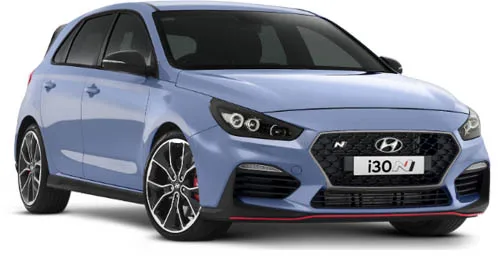
how we work and how we make money.
finder score: 86.25%
4 critics
how we work and how we make money.
Critic reviews
| Website | Rating | Notable quotes | |
|---|---|---|---|
| Motoring | 85% | "If Hyundai’s first attempt at a hot hatch is this good, we can’t wait to sample the next one." | Read more |
| Car Advice | 87% | "It punches far higher than its price tag suggests. And it should out-punch anything out there for similar money. " | Read more |
| Practical Motoring | 90% | " It’s a hot hatch that’s easy to drive which is great when you’re just dropping the kids to school or heading to the shops and an absolute hoot when you’re on a quiet and deserted twisting back road." | Read more |
| Cars Guide | 83% | "I’m going to put it out there and say that the i30 N Performance is absolutely going to be one of the standout new cars of 2018. " | Read more |
How does the Hyundai i30 N compare with its peers?
Compare some options to finance a Hyundai i30 N
Compare other products
We currently don't have that product, but here are others to consider:
How we picked theseFinder Score for car loans
To make comparing car loans even easier we came up with the Finder Score. Interest rates, fees and features across 200+ car loan products and 100+ lenders are all weighted and scaled to produce a score out of 10. The higher the score, the more competitive the product.
Compare car insurance side-by-side and get quotes
Compare other products
We currently don't have that product, but here are others to consider:
How we picked theseFinder Score for car insurance
We analyse over 30 car insurance products across insurance providers, and rate each one for price and features. We collect up to 36 quotes per product, for male and female drivers in New South Wales, Victoria, Queensland, South Australia, Tasmania and Western Australia. Quotes are collected for 20 year olds, 30 year olds and 60 year olds, assuming an excess of $850 for a 2020 Toyota Corolla 4 door sedan model, with an average 15,000 kms driven each year. We use your responses to our quiz to pair you with the closest price profile and while we are not allowed to display actual quotes, our price score aims to serve as an indicative guide to how cost competitive a product might be for you.
Our feature score assesses each product for more than 15 features across loss and damage coverage, repairs and assistance coverage, personal items coverage and policy coverage. Features we assess include but are not limited to legal liability, essential repairs, new car replacement, car hire events, roadside assistance, agreed or market value, windscreen damage and natural disaster coverage.
Depending on your answers to our car insurance quiz, we upweight the relevant price score or feature score to generate a dynamic Finder Score (80% weighting on the primary selection between Price or Feature). Finder Score, Price Score and Feature Score are only to be used as indicative guides and are not product recommendations.
Pictures: hyundai.com.au
Sources
Ask a question
More guides on Finder
-
Harmoney Car Loan
Looking for a car loan that’s fast, flexible and 100% online? Check out the Harmoney Car Loan here.
-
Compare car loans for classic cars
Want to buy a classic car but don't have the ready money? There are still financing options available for classic vehicles. Find out what loans you have to choose one and which one will work best for you.
-
Tesla Superchargers Map: Where you can charge in Australia
Find out the extent of Australia's Tesla Supercharger network with our complete map of every charging station.
-
Refinance Car Loans
If you are unhappy with your current car loan, refinancing it could be the right choice for you. Most people refinance their car loan to get a lower interest rate, get more flexibility in their car loan or get more additional features. Read our guide to see if it's right for you.
-
Cheap Car Loans Australia
When you're shopping around for a new car, you surely want the cheapest car loan possible.
-
Best Car Loans in Australia for 2025
The best car loan isn't necessarily the one with the lowest rate. Learn how to spot the best car loans and compare 15+ car loan products with Finder.
-
Car loan repayment calculator
Our car loan repayment calculator will help you work out how much your monthly, weekly or fortnightly car loan repayments will be to help you budget.
-
Secured Car Loans Australia
If you're looking to a buy a car you can consider a secured car loan to help finance your vehicle purchase. The loan is guaranteed so you can enjoy a lower interest rate – compare your options and apply today.
-
Used car loan rates Australia
You can still get a car loan if you want to finance a used car. Find out how you can get a used car loan and see what rates are available for the used car you want. Learn how to best compare lenders and apply for your loan today.
-
New Car Loan Interest Rates Australia
Whether you're upgrading your current car or looking for a new vehicle for your first car purchase, a new car loan can help you finance your set of wheels. Find out everything you need to know about new car loans to help you find the right loan for you.
